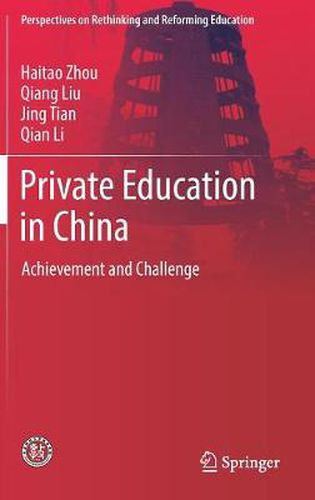Readings Newsletter
Become a Readings Member to make your shopping experience even easier.
Sign in or sign up for free!
You’re not far away from qualifying for FREE standard shipping within Australia
You’ve qualified for FREE standard shipping within Australia
The cart is loading…






This title is printed to order. This book may have been self-published. If so, we cannot guarantee the quality of the content. In the main most books will have gone through the editing process however some may not. We therefore suggest that you be aware of this before ordering this book. If in doubt check either the author or publisher’s details as we are unable to accept any returns unless they are faulty. Please contact us if you have any questions.
This book takes an in-depth look at the development of the private education sector in modern China. Readers will find valuable data and materials never before presented in such an accessible and transparent way, together with analyses of the major changes and challenges in the course of this development.
The book is organized both chronologically and by topic: it employs a past-present-future order that unites the general arrangement; at the same time, each specific subject is approached historically, not only to show the origins of the problem, but also to link it with the historical-comparative context, in which the evaluation of alternative policy choices become highly viable. Further, the book provides a pioneering account of current problems, adopting a fresh perspective to address the most important aspects of Chinese private education reform. The elaboration on topics concerning private school assets, property rights, legal personality, school operators’ entrepreneurship, benefits and investment returns, school autonomy, and the development of teachers and students, is both empirically rich and highly insightful. The book’s content is chiefly derived from years of fieldwork in private schools and from extensive interviews with hundreds of policy makers, school operators, managers, teachers and students. Since these people are self-conscious about themselves as the actors in and witnesses to the development of Chinese private education over the past three decades, the book places great emphasis on neutrality, allowing the private education landscape to unfold in the context of the privatization of the socialist system after 1978. The book offers an essential guide for anyone who wishes to understand the transformation of Chinese education. It is highly recommendable as a detailed introduction to Chinese education, or as a resource for comparative research on private education from an international perspective.
$9.00 standard shipping within Australia
FREE standard shipping within Australia for orders over $100.00
Express & International shipping calculated at checkout
This title is printed to order. This book may have been self-published. If so, we cannot guarantee the quality of the content. In the main most books will have gone through the editing process however some may not. We therefore suggest that you be aware of this before ordering this book. If in doubt check either the author or publisher’s details as we are unable to accept any returns unless they are faulty. Please contact us if you have any questions.
This book takes an in-depth look at the development of the private education sector in modern China. Readers will find valuable data and materials never before presented in such an accessible and transparent way, together with analyses of the major changes and challenges in the course of this development.
The book is organized both chronologically and by topic: it employs a past-present-future order that unites the general arrangement; at the same time, each specific subject is approached historically, not only to show the origins of the problem, but also to link it with the historical-comparative context, in which the evaluation of alternative policy choices become highly viable. Further, the book provides a pioneering account of current problems, adopting a fresh perspective to address the most important aspects of Chinese private education reform. The elaboration on topics concerning private school assets, property rights, legal personality, school operators’ entrepreneurship, benefits and investment returns, school autonomy, and the development of teachers and students, is both empirically rich and highly insightful. The book’s content is chiefly derived from years of fieldwork in private schools and from extensive interviews with hundreds of policy makers, school operators, managers, teachers and students. Since these people are self-conscious about themselves as the actors in and witnesses to the development of Chinese private education over the past three decades, the book places great emphasis on neutrality, allowing the private education landscape to unfold in the context of the privatization of the socialist system after 1978. The book offers an essential guide for anyone who wishes to understand the transformation of Chinese education. It is highly recommendable as a detailed introduction to Chinese education, or as a resource for comparative research on private education from an international perspective.